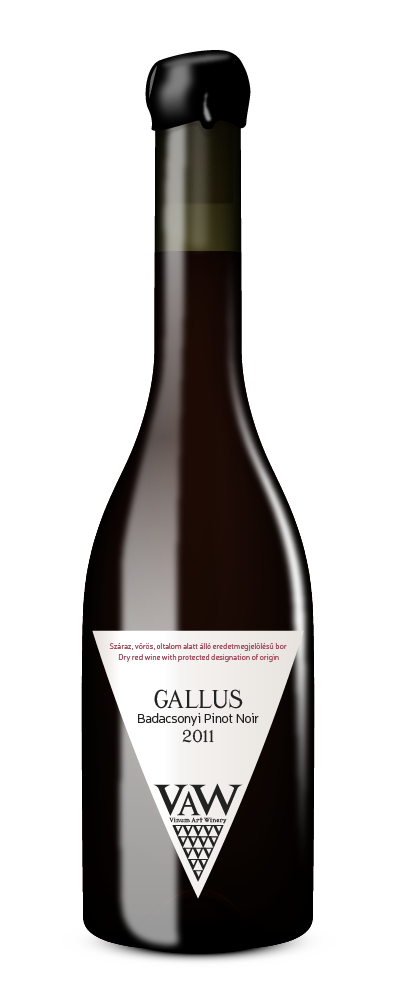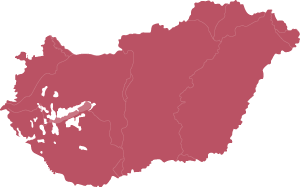Personal opinion:
Appealing style, firm and friendly, with the consistency characteristic of the year. Hill-side selection. This wine will also be the envy of the French as in my opinion it will bring better results than in its homeland. Well, I would not put this wine next to the French Pinot Noir but rather before that. Matured in two-year-old, second-filled wooden barrel. Worthy of everyone's attention - a unisex wine.
Gastronomical pairing:
I consumed it with beef paté on toast.
About the Pinot Noir variety:
The Pinot Noir is a world variety of French origin. In Hungary it could not become more widespread because of the Socialist large-scale production. Today we can talk about a variety that people have again taken a liking to, but its spread in Hungary is not significant. It was already a well-known and popular variety as Kisburgundi in the previous century.
As far as I know it is only typical in three wine regions in Hungary: Balaton, Villány, and Eger. I would maybe highlight Eger because the climate and conditions of that region most closely resemble those of the original Burgundian habitat, but with small style changes, they also make fine wines from it in the other two wine regions.
It favours chalky subsoils but also yields results on other types of soil - on loess and volcanic soil. It is a demanding variety. The acids of the Pinot Noir produced in Hungary are elegant, strongly varietal with a sufficient alcohol content. Its real structure develops after three years.
The region and its history:
In the Badacsony area, vines were grown in Roman times, and Emperor Probus had sizeable plantings here. At the time of the settlement of the Magyars in Hungary they already knew about vines and wine. They appreciated areas capable of growing vine. A significant part of the wine region was taken over by the church in the 13th century. In the 18th-19th century the Badacsony vermouth gained a similar reputation to that of the Tokaj aszú in Europe. During the reconstruction after the phylloxera epidemic, supporting walls were built to prevent soil erosion. New varieties also entered the area. The Szürkebarát was introduced from France by monks. Due to the special soil content it evolved into a typical local variety, the Szürkebarát, which botrytises in good years. The variety grown in the biggest amount is Olaszrizling that is in better years ripened on the stock longer, and is used to make ice wine or late-harvest hand-selected Olaszrizling. Szürkebarát, Tramini, Sárga muskotály, Rajnai rizling and Chardonnay are also present on the larger lands. Kéknyelű or " Blue Stem" used to be a characteristic wine of the region. It was significantly confined by the frost damage of the 1980's but is experiencing a revival today, and will be an emblematic wine of the Badacsony region again in the near future.
Badacsony wines are typically full-bodied, fiery, aromatic and mineralized. Traditional wine-making and maturation in wooden barrels are characteristic. Although reductive wine-making and other modern technologies are also spreading, they have not significantly changed the character of the region's wine, yet.
Climate and geography:
Badacsony is the highest mountain in the Tapolca Basin; it stands between two bays of Lake Balaton. The circumference of the almost round mountain is 11km, the diametre of its top region slightly elongated in the north-south direction is 1-1.5km, its highest point is 437.4 metres above sea level. Its hillside is covered up to 280 metres by various loose deposits that are excellent for growing vine, and its soil is basalt-based loess. It is covered by various loose deposit, Pannon clay and Pannon loess, above which there are basalt rocks.
Its climate is mild and balanced with high humidity. Because of the proximity of Lake Balaton the southern hills can also enjoy the sunshine reflected from the surface of the water, therefore there is a very beneficial microclimate that makes the making of natural dessert wine possible.
The wine region includes the vine cadastre-based first and second class border sections of the following settlements: Ábrahámhegy, Badacsonytomaj, Badacsonytördemic, Balatonrendes, Balatonszepezd, Diszel, Gyulakeszi, Hegymagas, Káptalantóti, Kisapáti, Kővágóörs, Nemesgulács, Raposka, Révfülöp, Salföld, Szigliget, Tapolca.
NAME: GALLUS
YEAR: 2011
VARIETY: Pinot noir
WINE REGION: Badacsony
CLASS: Dry red wine with protected designation of origin
Product of Hungary
Bottle volume: 750ml
Alc.13%vol
Contains sulfites


